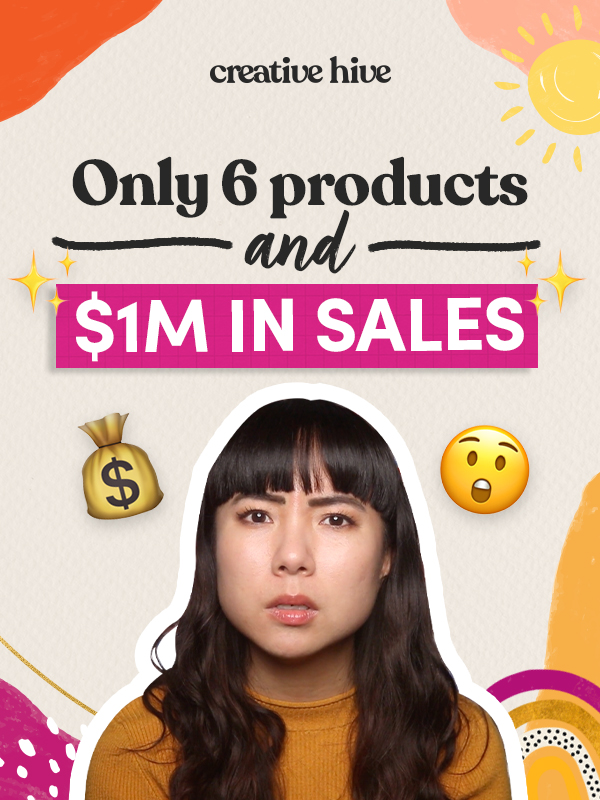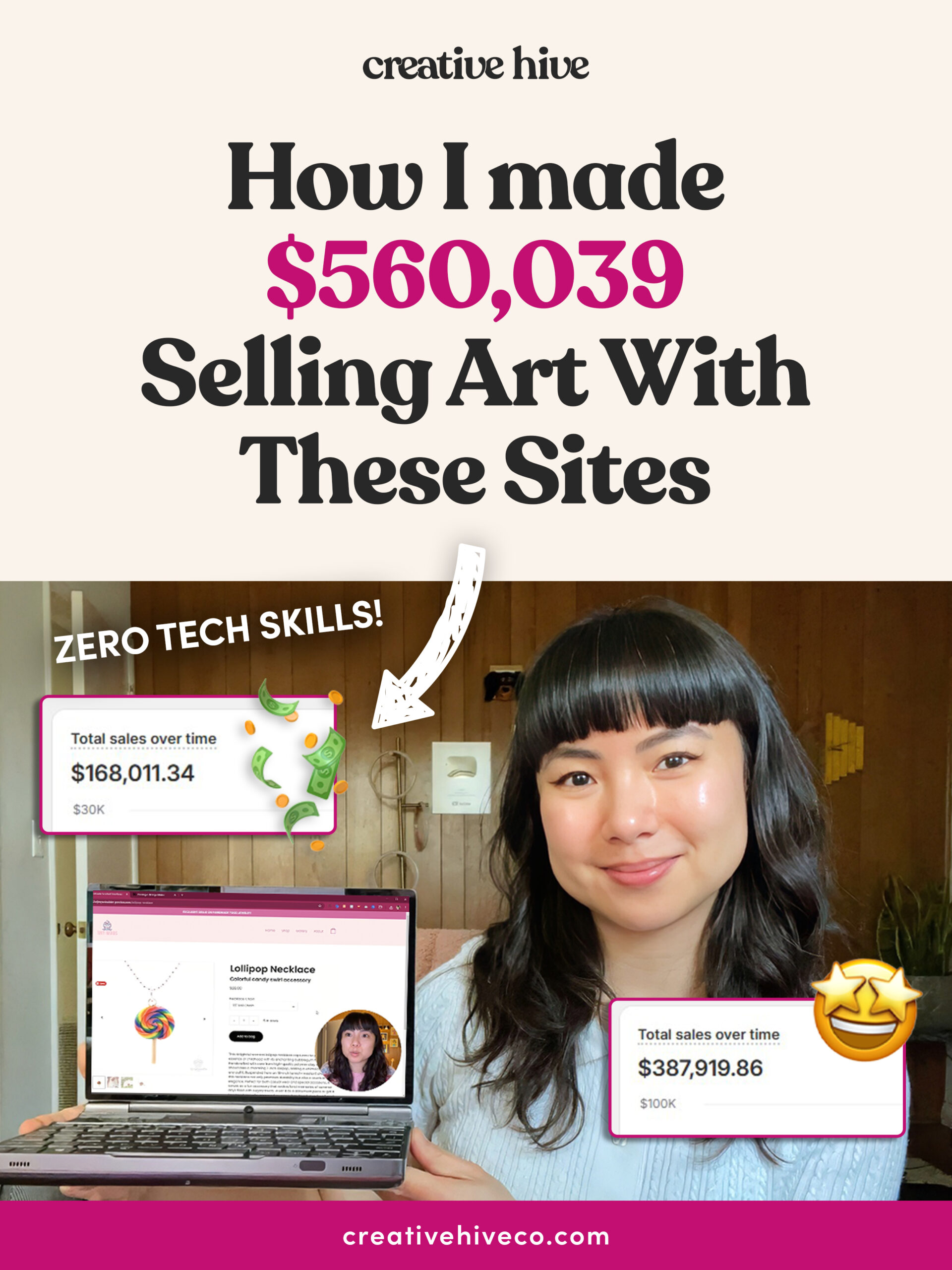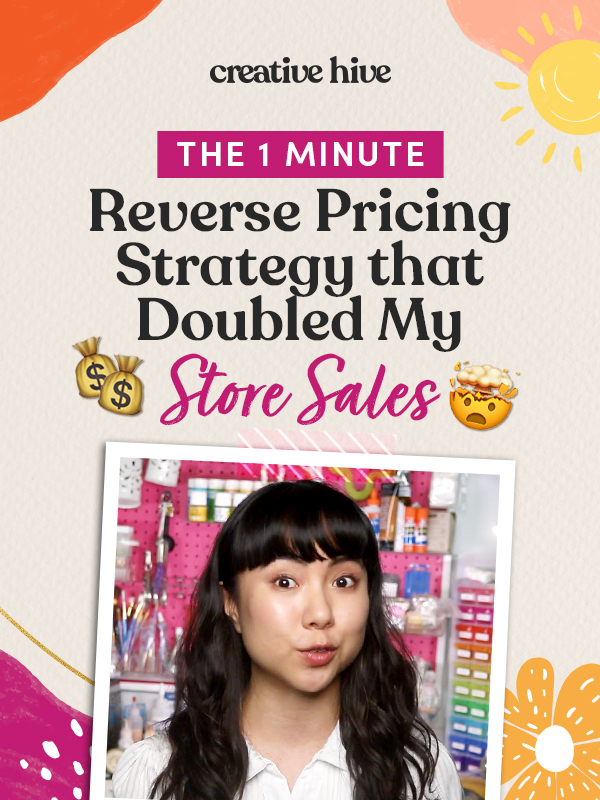How I (almost) doubled sales by wiping out half my product line
I want to help you build a sustainable, profitable handmade business that makes you consistent income and sales. I only ever teach or recommend marketing, social media, pricing, production and branding tips that I’ve personally used successfully in my own 7-figure handmade businesses.
I'm Mei, from Los Angeles!
Read More
Popular Posts You'll Love
Looking for something?
Categories
starting a business
get more traffic
running a business
make more sales
branding
growing a business
mindset & productivity
podcasts
pricing & money
product photography
reviews
selling on etsy
selling on amazon
social media
selling wholesale
- Facebook0
- Twitter0
- Pinterest0
- 0share
Having so many products in your shop is not doing what you think it is.
If you’re thinking, “I wanted to make more sales, so I’ll make something for everyone who visits my online store!”
But that’s not the way it works. More products doesn’t mean you’re appealing to everyone and it doesn’t increase your chances of making a sale.
In fact, it does quite the opposite.
Garage Sale Shop
Do you have a shop with so many products and options? For example, you sell pet collars in 10 colors or have hundreds of items available.
My jewelry store used to be like that, but then I ran an experiment.
Here’s what I found: it was actually costing me sales!
It may not appeal to anyone if you have too many products or options.
Think of it like buying a gift for a friend. If you don’t know them well, it’s hard to pick a gift they’ll love.
Same goes with your ideal customer, if they don’t love your product, they won’t buy it.
Your shop is like a garage sale. You’re selling a mix of items for different people, and it’s likely that you haven’t been able to think deeply about designing products for a specific customer.
Don’t worry!
My business used to be like that too. When you don’t know what your customers want, you’re taking a scattershot approach, hoping something sticks.
However, doing nothing about it can actually put your business at risk.
Your customer may lose trust in you as a seller or artist.
Even if your products are well made, you risk giving off the idea that you’re indecisive or you don’t know your customer.
Remember, customers need to trust you with their money, so it’s important to show professionalism in your business.
In my case, the three physical product shops I own have smaller product lines.
One has made millions in sales with just 6 products—it used to have at least double, but we cut down our offerings.
Another shop has made about $10,000 with only 26 products. In my coaching business, Creative Hive, I sold just one course for years before adding more.
My main jewelry shop, Tiny Hands, offers 62 polymer clay charms options, the biggest line that I have.
A few months ago, I did a test on this shop by removing the unscented option for jewelry. In the past, customers could choose between scented and unscented, with a 15% discount for unscented.
The results:
- I actually made more sales!
- Shopping is made easier and simpler for customers
- Save on supply costs
Here’s the takeaway: you don’t need a lot of products to make a lot of money.

Supplies-First vs. Customer Demand-First
When people are faced with so many options, it’s overwhelming and confusing.
Customers may get stuck in analysis paralysis, resulting in making no decisions at all.
You need to help them. Curating your product line to showcase only your best items is a good way to start.
You don’t want to be a shop that sells mixed items in one place. It will actually harm your supply costs for having a huge product line that barely sells.
The more that all your products can share the same pool of supplies, the better. You’ll save on costs and storage space too.
There are some artists who feel pressured to salvage supplies that haven’t been used.
This is what happens if you create products with a supplies-first approach, making it difficult to sell because you don’t know if your customers will actually spend their money on it.
When you create new products, you want to use customer demand-first approach where you use research to help guide you to what designs to make.
It will help your work sell more easily. Plus, removing poorly selling items will help you more than you think.
You’re not only cutting down costs but also doing yourself a favor by making things easier for you.
It saves you from the demand of putting extra energy, money, time and mental space to manage.
Imagine preparing for a show. It’s easier with 50 items than 150.
It’s not a badge of honor to have hundreds of products. It means so much more stuff to worry and think about and it makes your business so much less flexible and agile.
Sunk Cost Fallacy
I like to tap into Marie Kondo’s KonMari method of tidying up.
Rule number six of this method is asking yourself if it sparks joy before you throw it away, gift it, or donate it.
Ask yourself: Is my product making meaningful sales to justify its space in my line and mind?
I regularly remove designs from my shop. It’s easy to check sales reports and remove items that make up 1% or less of my total sales.
Letting go of products can feel really difficult especially when you’ve poured your heart and soul into creating it.
This is called Sunk Cost Fallacy, where artists are resistant to make any changes because of the effort they invested into something in the past. Even if it’s clear that abandoning that item is the right thing to do.
Here’s a reminder: Your past doesn’t define your future. Sometimes, it carries baggage that can hold you back from making decisions.
It is important to think that it’s okay to create art for your enjoyment alone. Some of it doesn’t have to be shared with everyone else.
Not everything you make has to be put on your store for sale with a price tag on it.
When you feel like everything you make has to be made for sale, that’s when things lead to creative burnout and you’ll start to resent your business and your art.

Make It Easy
I am writing a book called Make It Easy, which is about anti-hustle culture.
In this book, I talk about my four-step system on how to achieve anything you want in your life, particularly business, career and creative goals.
The first major step is all about letting go.
You will find more success when you let go of what no longer serves you— like products that confuse customers or don’t sell well.
Keep in mind that you need a customer demand-first approach backed up by research, so you’ll know if there’s a need for the product.
You’re not only creating your product for its own sake but creating for customers in mind.
Most artists just make art because their heart call them to it, which is great but oftentimes this does not lead to a product with commercial value, and therefore, doesn’t sell well.
On Etsy, having a lot of products can be a smart strategy since each listing ranks for its own keywords, allowing customers to find specific items like “Mother’s Day gift” or “gold necklace for girlfriend”.
In some cases, shoppers on Etsy, Amazon or Target will most likely go directly to your listing and will either buy or move on to similar options without even clicking your entire shop.
Now, if you’re selling on your own website, or even at a craft show, this strategy of having lots of products will backfire on you.
It harms branding because most customers who shop on Etsy never remember the shop names they bought from.
When customers see your entire product line, your items should look cohesive and unified.
It’s better when things are easy than hard. If there’s an easier way to reach my business goals, you betcha I’m taking that route!
Think of the time you saved by not having to constantly design and list new items. Many artists believe that making more products leads to more sales, but that’s not true at all.
If you want to increase your sales without making so many products and get off Etsy or social media— join my free workshop about how to make sales on your own website.
For some of us, we have such large product lines, because we are scared to make a decision to narrow things down. This is also coupled with the idea that the more products we have, the more sales we stand to gain— which hopefully, now you know, is absolutely not true.
I totally get that taking the step to narrow down your products feels limiting and scary at the same time.
What if I told you that it will actually help you make more sales and be creatively free?
Think of it like drawing something without anything in mind. You might feel stuck, but if I say, “draw a sunflower and a bee”, you know exactly what to do because it’s clear and specific.
It doesn’t feel like a constraint or limitation. You can draw the sunflower and bee however you like, and it will be much easier with some scope to start.
If you’re still scared and hesitant to take this step, try to imagine how your customer is feeling.
Your customer is a stranger who knows nothing about you and doesn’t owe you anything.
If you struggle to narrow down your options, it will be hard for them to decide too when faced with so many choices.
If you want to make money from your business, the onus is on us as the business owner. Cut down your products or options to make it easy for customers to choose and buy your items.
I’ll say it again, you don’t need to create more products to make more money.
The Nerdy Creatives Club
If you’re curious about how I did the test in my shop, and how you could do this on your own, I’m starting a thing called the Nerdy Creatives Club which is all about these small tests you can do in an afternoon to help you increase sales or save time in your business.
It’s a waitlist only, so if you’re interested, click here to join.

Leave a Comment
Liked this article? Share it!
Unlock a Profitable Handmade Business
in Just 12 Weeks Without Using Etsy
or Social Media
FREE WORKSHOP
This workshop is for anyone who makes and sells a handmade or physical product, including jewelry designers, artists, paper designers, bath & body product makers and more!
What You'll Discover
The #1 mistake people make with Etsy & social media that causes shops to FLOP
The secret to making it with your handmade shop so it's no longer just a hobby
How to make sales in your handmade shop with ease so you can finally get to 6-figures
TAKE ME THERE
Your email address will not be published. Required fields are marked *
Leave a Reply Cancel reply
About
Blog
A Sale A Day
Student Login
Free Class
Contact
Terms
Become A Student
Watch On YouTube
Student Reviews
See My Handmade Shop!


Hey. The number pattern calculator https://calculatorprofessional.com/number-sequence-calculator is a highly useful tool for anyone dealing with numerical sequences and patterns. It’s easy to use and provides quick, accurate results, making it a go-to resource for students, teachers, and professionals alike. I love how versatile it is, allowing you to identify and solve different types of number patterns, whether arithmetic, geometric, or something more complex. This tool has helped me a lot in understanding and verifying patterns in math assignments, saving me time and effort. If you’re looking for a reliable way to work with number patterns, this calculator is definitely worth trying!
The insights provided in this essay offered a fresh viewpoint on the subject, which I found to be really insightful and thought-provoking.
When running a business, understanding wholesale prices is crucial to maximize profits. I am currently running a beauty store and am looking to purchase eyelash extension shampoos at wholesale prices. Anyone here who recommend me a reliable company for high quality products?
Grateful for the clarity and thoughtfulness in this article. It’s a valuable read! SSM Smart Square
I love the analogy of buying a gift for a friend. It really highlights the importance of knowing your customer. If you don’t understand their needs and preferences, it’s impossible to create products they’ll truly love and buy.
Simplify your product line! Too many choices overwhelm customers. Focus on bestsellers, mirroring efficient games like Snow Rider 3D with its simple yet engaging gameplay. Cut costs, save time, and boost sales by curating your offerings. Ditch the sunk cost fallacy and prioritize customer demand. More isn’t always better.
The Plinko demo lets players experience the excitement of the game without spending real money. It’s perfect for testing strategies, understanding mechanics, or just having fun with no pressure. The demo version has the same visuals and gameplay as the full version, making it ideal for beginners and curious players who want to explore Plinko before playing for real stakes.
Having too many products can overwhelm customers. It’s like facing a level in Geometry Dash with too many obstacles. Simplify your offerings to focus on quality and appeal to your ideal customer. A curated selection builds trust and increases sales. Narrowing down options, like removing the unscented option, can surprisingly boost your revenue. Think quality over quantity for a successful online shop.